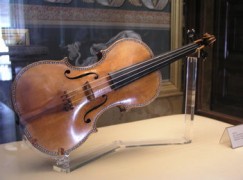New research: The Stradivarius secret – could it be woodworm?
mainA team of researchers at National Taiwan University believe that the unique sound of Stradivarius instruments may have arisen from a secret anti-woodworm treatment applied by the master-luthier.
Our analysis of Stradivari’s maples from three independent sources showed reproducible differences in chemical compositions compared with modern maples. Stradivari’s use of mineral-treated maples belonged to a forgotten tradition unknown to later violin makers. His maple also appeared to be transformed by aging and vibration, resulting in a unique composite material unavailable to modern makers. Modern chemical analyses may, therefore, improve our understanding of Stradivari’s unique craft and inspire the development of novel material approaches in instrument making.
Read on here.






My friend Andrea Pallavi from Cremona, stemming from a long line of generations going back to Stradivari’s neighbours, claims the so-called secret of the violin maker was his wife, who once mislaid a newly-produced instrument in the oven where it got accidentally sprinkled with a mixture of olive oil and cinnamon, and got heated-up considerably. This improved the sound quality so much that from that day onwards, his wife formed part of the production line.
Only problem is that violinists have failed miserably in double blind tests, while both playing AND listening, to identify the “unique” sound of a Stradivarius.
So what, exactly, is this secret they are looking for?
Very interesting paper, especially in the breadth of experimental techniques brought to the problem. I was surprised that varnish was never mentioned explicitly except in one reference. I’ve also read that logs that eventually became these instruments may have been floated to Cremona over the Po river. If so, it seems possible that minerals may have penetrated the wood and remained long after drying.